GDP Calculation: Expenditure & Income Approaches - Economics Data
VerifiedAdded on 2023/04/21
|13
|2649
|279
Homework Assignment
AI Summary
This economics assignment provides a detailed analysis of Gross Domestic Product (GDP) calculation using both the expenditure and income approaches. The expenditure approach analyzes nominal and real GDP with components like personal consumption, investment, net exports, and government spending, highlighting the impact of inflation and trade deficits. The income approach examines GDP, Gross National Product (GNP), Net National Product (NNP), National Income (NI), and Personal Income, emphasizing the importance of compensation to employees. Furthermore, the assignment compares GDP and per capita GDP across eight selected countries, revealing differences in economic performance and living standards. Finally, the report analyzes the index of economic freedom, business freedom, trade freedom, and financial freedom and property rights for the eight countries. Desklib offers a wide range of study tools and solved assignments for students.

Running head: ECONOMICS
Economics
Name of the Student
Name of the University
Course ID
Economics
Name of the Student
Name of the University
Course ID
Paraphrase This Document
Need a fresh take? Get an instant paraphrase of this document with our AI Paraphraser
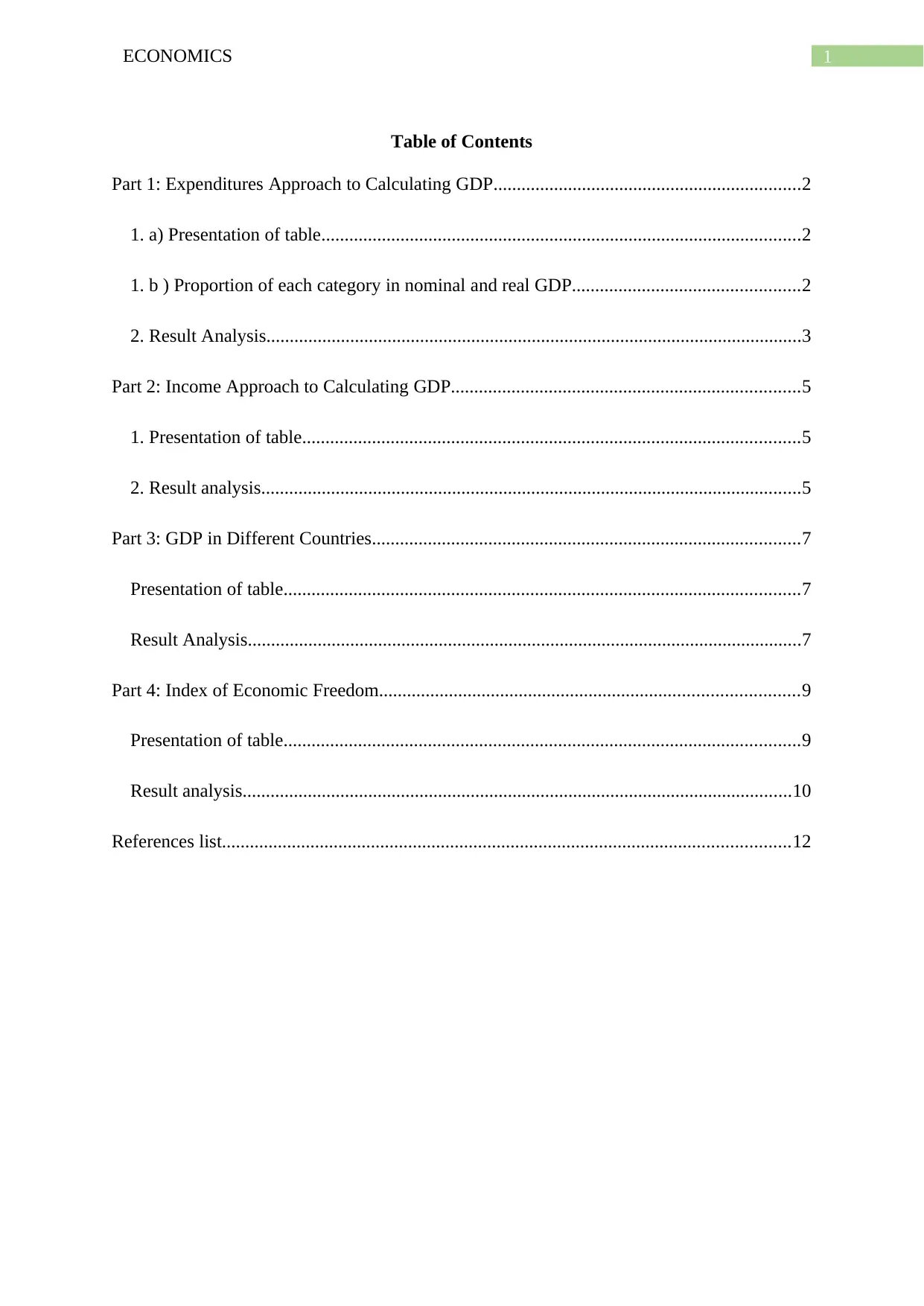
1ECONOMICS
Table of Contents
Part 1: Expenditures Approach to Calculating GDP..................................................................2
1. a) Presentation of table.......................................................................................................2
1. b ) Proportion of each category in nominal and real GDP.................................................2
2. Result Analysis...................................................................................................................3
Part 2: Income Approach to Calculating GDP...........................................................................5
1. Presentation of table...........................................................................................................5
2. Result analysis....................................................................................................................5
Part 3: GDP in Different Countries............................................................................................7
Presentation of table...............................................................................................................7
Result Analysis.......................................................................................................................7
Part 4: Index of Economic Freedom..........................................................................................9
Presentation of table...............................................................................................................9
Result analysis......................................................................................................................10
References list..........................................................................................................................12
Table of Contents
Part 1: Expenditures Approach to Calculating GDP..................................................................2
1. a) Presentation of table.......................................................................................................2
1. b ) Proportion of each category in nominal and real GDP.................................................2
2. Result Analysis...................................................................................................................3
Part 2: Income Approach to Calculating GDP...........................................................................5
1. Presentation of table...........................................................................................................5
2. Result analysis....................................................................................................................5
Part 3: GDP in Different Countries............................................................................................7
Presentation of table...............................................................................................................7
Result Analysis.......................................................................................................................7
Part 4: Index of Economic Freedom..........................................................................................9
Presentation of table...............................................................................................................9
Result analysis......................................................................................................................10
References list..........................................................................................................................12
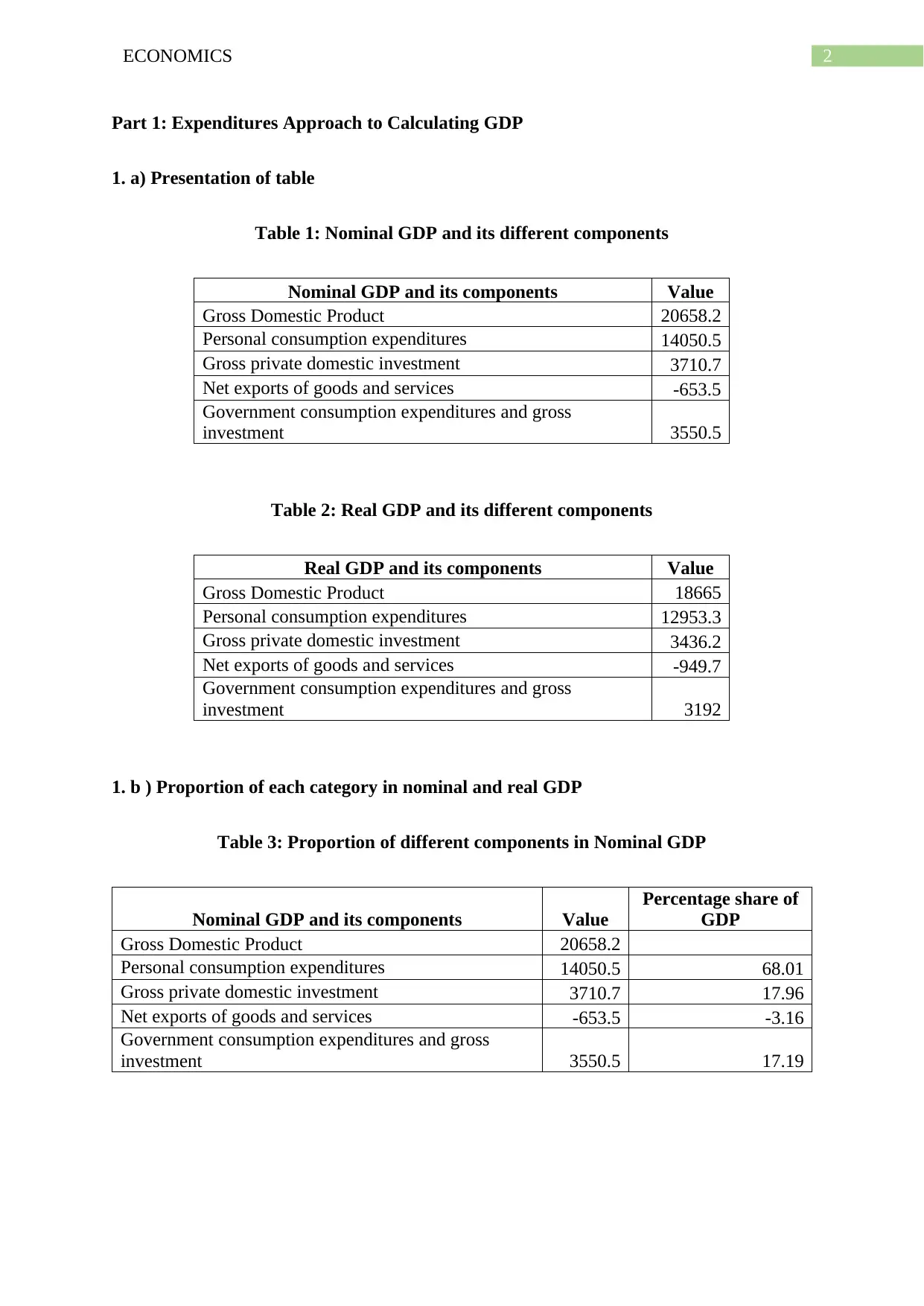
2ECONOMICS
Part 1: Expenditures Approach to Calculating GDP
1. a) Presentation of table
Table 1: Nominal GDP and its different components
Nominal GDP and its components Value
Gross Domestic Product 20658.2
Personal consumption expenditures 14050.5
Gross private domestic investment 3710.7
Net exports of goods and services -653.5
Government consumption expenditures and gross
investment 3550.5
Table 2: Real GDP and its different components
Real GDP and its components Value
Gross Domestic Product 18665
Personal consumption expenditures 12953.3
Gross private domestic investment 3436.2
Net exports of goods and services -949.7
Government consumption expenditures and gross
investment 3192
1. b ) Proportion of each category in nominal and real GDP
Table 3: Proportion of different components in Nominal GDP
Nominal GDP and its components Value
Percentage share of
GDP
Gross Domestic Product 20658.2
Personal consumption expenditures 14050.5 68.01
Gross private domestic investment 3710.7 17.96
Net exports of goods and services -653.5 -3.16
Government consumption expenditures and gross
investment 3550.5 17.19
Part 1: Expenditures Approach to Calculating GDP
1. a) Presentation of table
Table 1: Nominal GDP and its different components
Nominal GDP and its components Value
Gross Domestic Product 20658.2
Personal consumption expenditures 14050.5
Gross private domestic investment 3710.7
Net exports of goods and services -653.5
Government consumption expenditures and gross
investment 3550.5
Table 2: Real GDP and its different components
Real GDP and its components Value
Gross Domestic Product 18665
Personal consumption expenditures 12953.3
Gross private domestic investment 3436.2
Net exports of goods and services -949.7
Government consumption expenditures and gross
investment 3192
1. b ) Proportion of each category in nominal and real GDP
Table 3: Proportion of different components in Nominal GDP
Nominal GDP and its components Value
Percentage share of
GDP
Gross Domestic Product 20658.2
Personal consumption expenditures 14050.5 68.01
Gross private domestic investment 3710.7 17.96
Net exports of goods and services -653.5 -3.16
Government consumption expenditures and gross
investment 3550.5 17.19
⊘ This is a preview!⊘
Do you want full access?
Subscribe today to unlock all pages.

Trusted by 1+ million students worldwide
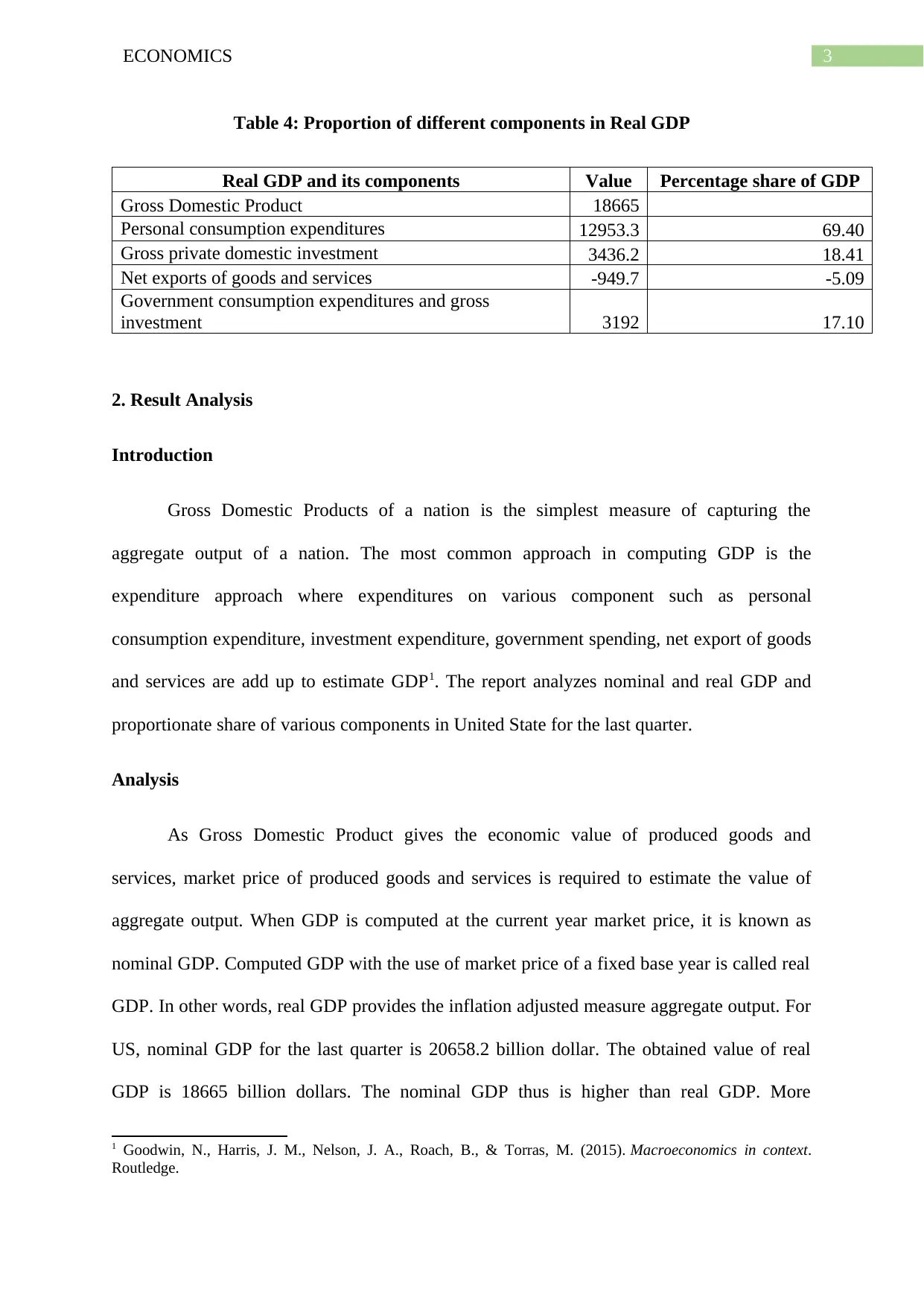
3ECONOMICS
Table 4: Proportion of different components in Real GDP
Real GDP and its components Value Percentage share of GDP
Gross Domestic Product 18665
Personal consumption expenditures 12953.3 69.40
Gross private domestic investment 3436.2 18.41
Net exports of goods and services -949.7 -5.09
Government consumption expenditures and gross
investment 3192 17.10
2. Result Analysis
Introduction
Gross Domestic Products of a nation is the simplest measure of capturing the
aggregate output of a nation. The most common approach in computing GDP is the
expenditure approach where expenditures on various component such as personal
consumption expenditure, investment expenditure, government spending, net export of goods
and services are add up to estimate GDP1. The report analyzes nominal and real GDP and
proportionate share of various components in United State for the last quarter.
Analysis
As Gross Domestic Product gives the economic value of produced goods and
services, market price of produced goods and services is required to estimate the value of
aggregate output. When GDP is computed at the current year market price, it is known as
nominal GDP. Computed GDP with the use of market price of a fixed base year is called real
GDP. In other words, real GDP provides the inflation adjusted measure aggregate output. For
US, nominal GDP for the last quarter is 20658.2 billion dollar. The obtained value of real
GDP is 18665 billion dollars. The nominal GDP thus is higher than real GDP. More
1 Goodwin, N., Harris, J. M., Nelson, J. A., Roach, B., & Torras, M. (2015). Macroeconomics in context.
Routledge.
Table 4: Proportion of different components in Real GDP
Real GDP and its components Value Percentage share of GDP
Gross Domestic Product 18665
Personal consumption expenditures 12953.3 69.40
Gross private domestic investment 3436.2 18.41
Net exports of goods and services -949.7 -5.09
Government consumption expenditures and gross
investment 3192 17.10
2. Result Analysis
Introduction
Gross Domestic Products of a nation is the simplest measure of capturing the
aggregate output of a nation. The most common approach in computing GDP is the
expenditure approach where expenditures on various component such as personal
consumption expenditure, investment expenditure, government spending, net export of goods
and services are add up to estimate GDP1. The report analyzes nominal and real GDP and
proportionate share of various components in United State for the last quarter.
Analysis
As Gross Domestic Product gives the economic value of produced goods and
services, market price of produced goods and services is required to estimate the value of
aggregate output. When GDP is computed at the current year market price, it is known as
nominal GDP. Computed GDP with the use of market price of a fixed base year is called real
GDP. In other words, real GDP provides the inflation adjusted measure aggregate output. For
US, nominal GDP for the last quarter is 20658.2 billion dollar. The obtained value of real
GDP is 18665 billion dollars. The nominal GDP thus is higher than real GDP. More
1 Goodwin, N., Harris, J. M., Nelson, J. A., Roach, B., & Torras, M. (2015). Macroeconomics in context.
Routledge.
Paraphrase This Document
Need a fresh take? Get an instant paraphrase of this document with our AI Paraphraser
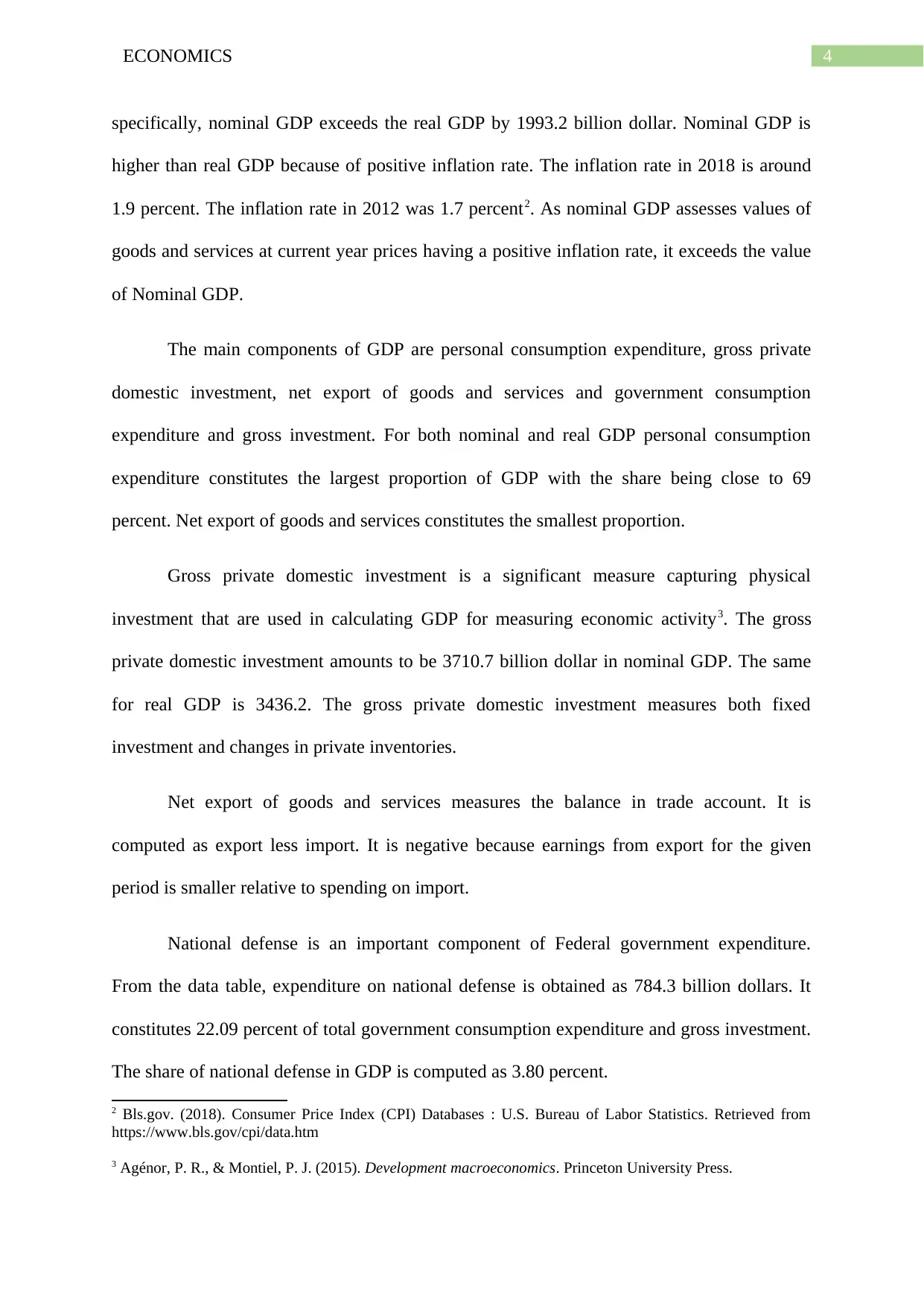
4ECONOMICS
specifically, nominal GDP exceeds the real GDP by 1993.2 billion dollar. Nominal GDP is
higher than real GDP because of positive inflation rate. The inflation rate in 2018 is around
1.9 percent. The inflation rate in 2012 was 1.7 percent2. As nominal GDP assesses values of
goods and services at current year prices having a positive inflation rate, it exceeds the value
of Nominal GDP.
The main components of GDP are personal consumption expenditure, gross private
domestic investment, net export of goods and services and government consumption
expenditure and gross investment. For both nominal and real GDP personal consumption
expenditure constitutes the largest proportion of GDP with the share being close to 69
percent. Net export of goods and services constitutes the smallest proportion.
Gross private domestic investment is a significant measure capturing physical
investment that are used in calculating GDP for measuring economic activity3. The gross
private domestic investment amounts to be 3710.7 billion dollar in nominal GDP. The same
for real GDP is 3436.2. The gross private domestic investment measures both fixed
investment and changes in private inventories.
Net export of goods and services measures the balance in trade account. It is
computed as export less import. It is negative because earnings from export for the given
period is smaller relative to spending on import.
National defense is an important component of Federal government expenditure.
From the data table, expenditure on national defense is obtained as 784.3 billion dollars. It
constitutes 22.09 percent of total government consumption expenditure and gross investment.
The share of national defense in GDP is computed as 3.80 percent.
2 Bls.gov. (2018). Consumer Price Index (CPI) Databases : U.S. Bureau of Labor Statistics. Retrieved from
https://www.bls.gov/cpi/data.htm
3 Agénor, P. R., & Montiel, P. J. (2015). Development macroeconomics. Princeton University Press.
specifically, nominal GDP exceeds the real GDP by 1993.2 billion dollar. Nominal GDP is
higher than real GDP because of positive inflation rate. The inflation rate in 2018 is around
1.9 percent. The inflation rate in 2012 was 1.7 percent2. As nominal GDP assesses values of
goods and services at current year prices having a positive inflation rate, it exceeds the value
of Nominal GDP.
The main components of GDP are personal consumption expenditure, gross private
domestic investment, net export of goods and services and government consumption
expenditure and gross investment. For both nominal and real GDP personal consumption
expenditure constitutes the largest proportion of GDP with the share being close to 69
percent. Net export of goods and services constitutes the smallest proportion.
Gross private domestic investment is a significant measure capturing physical
investment that are used in calculating GDP for measuring economic activity3. The gross
private domestic investment amounts to be 3710.7 billion dollar in nominal GDP. The same
for real GDP is 3436.2. The gross private domestic investment measures both fixed
investment and changes in private inventories.
Net export of goods and services measures the balance in trade account. It is
computed as export less import. It is negative because earnings from export for the given
period is smaller relative to spending on import.
National defense is an important component of Federal government expenditure.
From the data table, expenditure on national defense is obtained as 784.3 billion dollars. It
constitutes 22.09 percent of total government consumption expenditure and gross investment.
The share of national defense in GDP is computed as 3.80 percent.
2 Bls.gov. (2018). Consumer Price Index (CPI) Databases : U.S. Bureau of Labor Statistics. Retrieved from
https://www.bls.gov/cpi/data.htm
3 Agénor, P. R., & Montiel, P. J. (2015). Development macroeconomics. Princeton University Press.

5ECONOMICS
Conclusion
The data summarizes nominal and real GDP and its different components for the US
economy. The nominal GDP is relatively higher than real GDP indicating positive
inflationary effect on aggregate output. The most important component of GDP is the
personal consumption expenditure constituting the largest share of GDP. Net export of goods
and services has an adverse effect on GDP because of the on-going trade deficit. Finally, the
analysis shows national defense to be an important part of federal government expenditure.
Part 2: Income Approach to Calculating GDP
1. Presentation of table
Table 5: GDP, GNP, NNP, NI and personal income
Components Q1 Q2 Q3
Gross domestic produ
ct
20,041.
0
20,411.
9
20,658.
2
Gross national produc
t 20309.8 20678.9 20913.3
Net national product 17,106.
4
17,425.
1
17,615.
6
National income 17266.2 17423.7 17659.3
Personal income 17319.2 17466.7 17644.5
2. Result analysis
Introduction
Income approach is one of the popular approach for estimating GDP. The report
briefly discusses different income components related to aggregate income. These include
gross domestic product, gross national product, net national product, national income and
personal income. Data on different indicator has been collected for the last year and then
analysis has been for clear understanding of national income accounts.
Conclusion
The data summarizes nominal and real GDP and its different components for the US
economy. The nominal GDP is relatively higher than real GDP indicating positive
inflationary effect on aggregate output. The most important component of GDP is the
personal consumption expenditure constituting the largest share of GDP. Net export of goods
and services has an adverse effect on GDP because of the on-going trade deficit. Finally, the
analysis shows national defense to be an important part of federal government expenditure.
Part 2: Income Approach to Calculating GDP
1. Presentation of table
Table 5: GDP, GNP, NNP, NI and personal income
Components Q1 Q2 Q3
Gross domestic produ
ct
20,041.
0
20,411.
9
20,658.
2
Gross national produc
t 20309.8 20678.9 20913.3
Net national product 17,106.
4
17,425.
1
17,615.
6
National income 17266.2 17423.7 17659.3
Personal income 17319.2 17466.7 17644.5
2. Result analysis
Introduction
Income approach is one of the popular approach for estimating GDP. The report
briefly discusses different income components related to aggregate income. These include
gross domestic product, gross national product, net national product, national income and
personal income. Data on different indicator has been collected for the last year and then
analysis has been for clear understanding of national income accounts.
⊘ This is a preview!⊘
Do you want full access?
Subscribe today to unlock all pages.

Trusted by 1+ million students worldwide
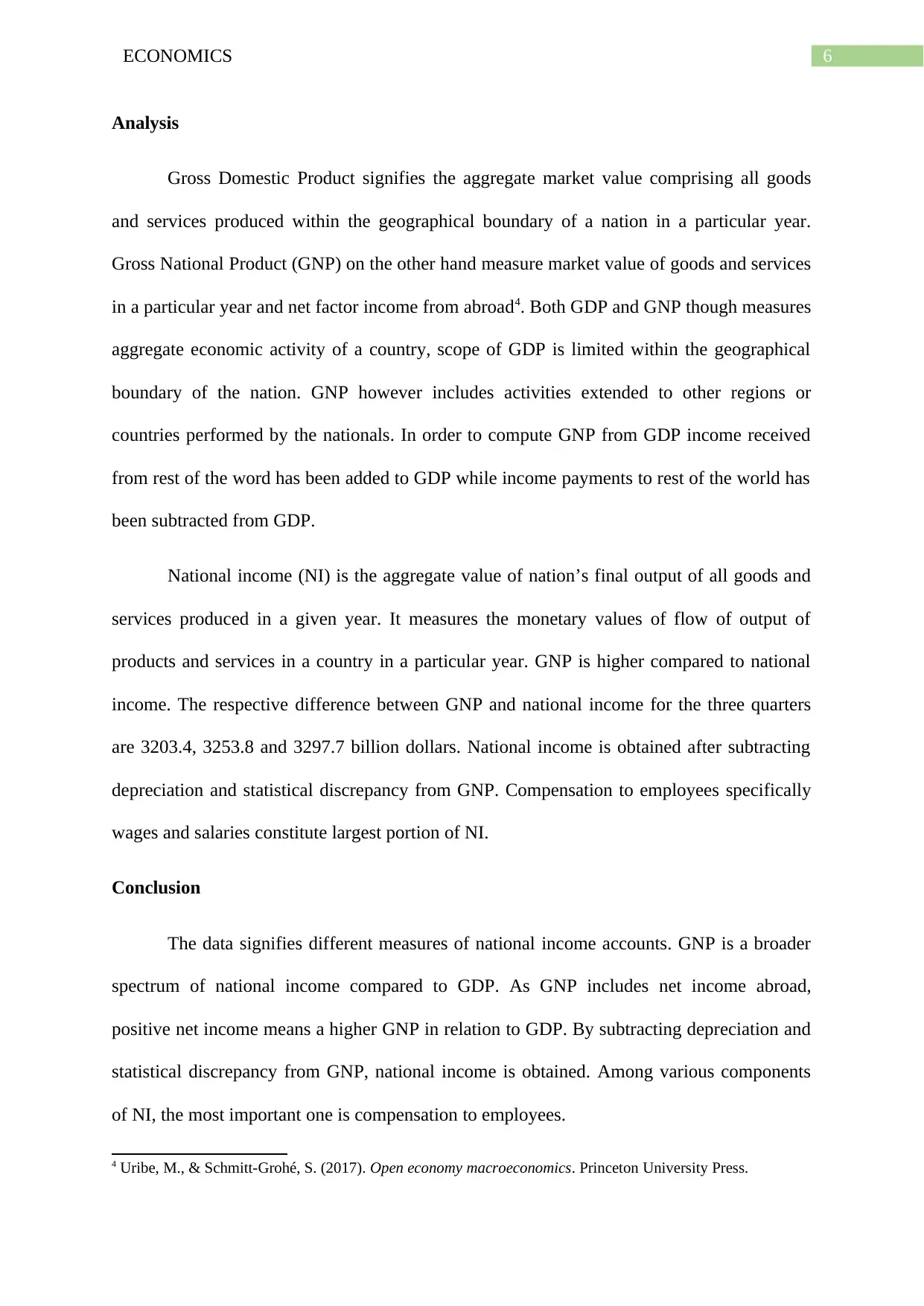
6ECONOMICS
Analysis
Gross Domestic Product signifies the aggregate market value comprising all goods
and services produced within the geographical boundary of a nation in a particular year.
Gross National Product (GNP) on the other hand measure market value of goods and services
in a particular year and net factor income from abroad4. Both GDP and GNP though measures
aggregate economic activity of a country, scope of GDP is limited within the geographical
boundary of the nation. GNP however includes activities extended to other regions or
countries performed by the nationals. In order to compute GNP from GDP income received
from rest of the word has been added to GDP while income payments to rest of the world has
been subtracted from GDP.
National income (NI) is the aggregate value of nation’s final output of all goods and
services produced in a given year. It measures the monetary values of flow of output of
products and services in a country in a particular year. GNP is higher compared to national
income. The respective difference between GNP and national income for the three quarters
are 3203.4, 3253.8 and 3297.7 billion dollars. National income is obtained after subtracting
depreciation and statistical discrepancy from GNP. Compensation to employees specifically
wages and salaries constitute largest portion of NI.
Conclusion
The data signifies different measures of national income accounts. GNP is a broader
spectrum of national income compared to GDP. As GNP includes net income abroad,
positive net income means a higher GNP in relation to GDP. By subtracting depreciation and
statistical discrepancy from GNP, national income is obtained. Among various components
of NI, the most important one is compensation to employees.
4 Uribe, M., & Schmitt-Grohé, S. (2017). Open economy macroeconomics. Princeton University Press.
Analysis
Gross Domestic Product signifies the aggregate market value comprising all goods
and services produced within the geographical boundary of a nation in a particular year.
Gross National Product (GNP) on the other hand measure market value of goods and services
in a particular year and net factor income from abroad4. Both GDP and GNP though measures
aggregate economic activity of a country, scope of GDP is limited within the geographical
boundary of the nation. GNP however includes activities extended to other regions or
countries performed by the nationals. In order to compute GNP from GDP income received
from rest of the word has been added to GDP while income payments to rest of the world has
been subtracted from GDP.
National income (NI) is the aggregate value of nation’s final output of all goods and
services produced in a given year. It measures the monetary values of flow of output of
products and services in a country in a particular year. GNP is higher compared to national
income. The respective difference between GNP and national income for the three quarters
are 3203.4, 3253.8 and 3297.7 billion dollars. National income is obtained after subtracting
depreciation and statistical discrepancy from GNP. Compensation to employees specifically
wages and salaries constitute largest portion of NI.
Conclusion
The data signifies different measures of national income accounts. GNP is a broader
spectrum of national income compared to GDP. As GNP includes net income abroad,
positive net income means a higher GNP in relation to GDP. By subtracting depreciation and
statistical discrepancy from GNP, national income is obtained. Among various components
of NI, the most important one is compensation to employees.
4 Uribe, M., & Schmitt-Grohé, S. (2017). Open economy macroeconomics. Princeton University Press.
Paraphrase This Document
Need a fresh take? Get an instant paraphrase of this document with our AI Paraphraser
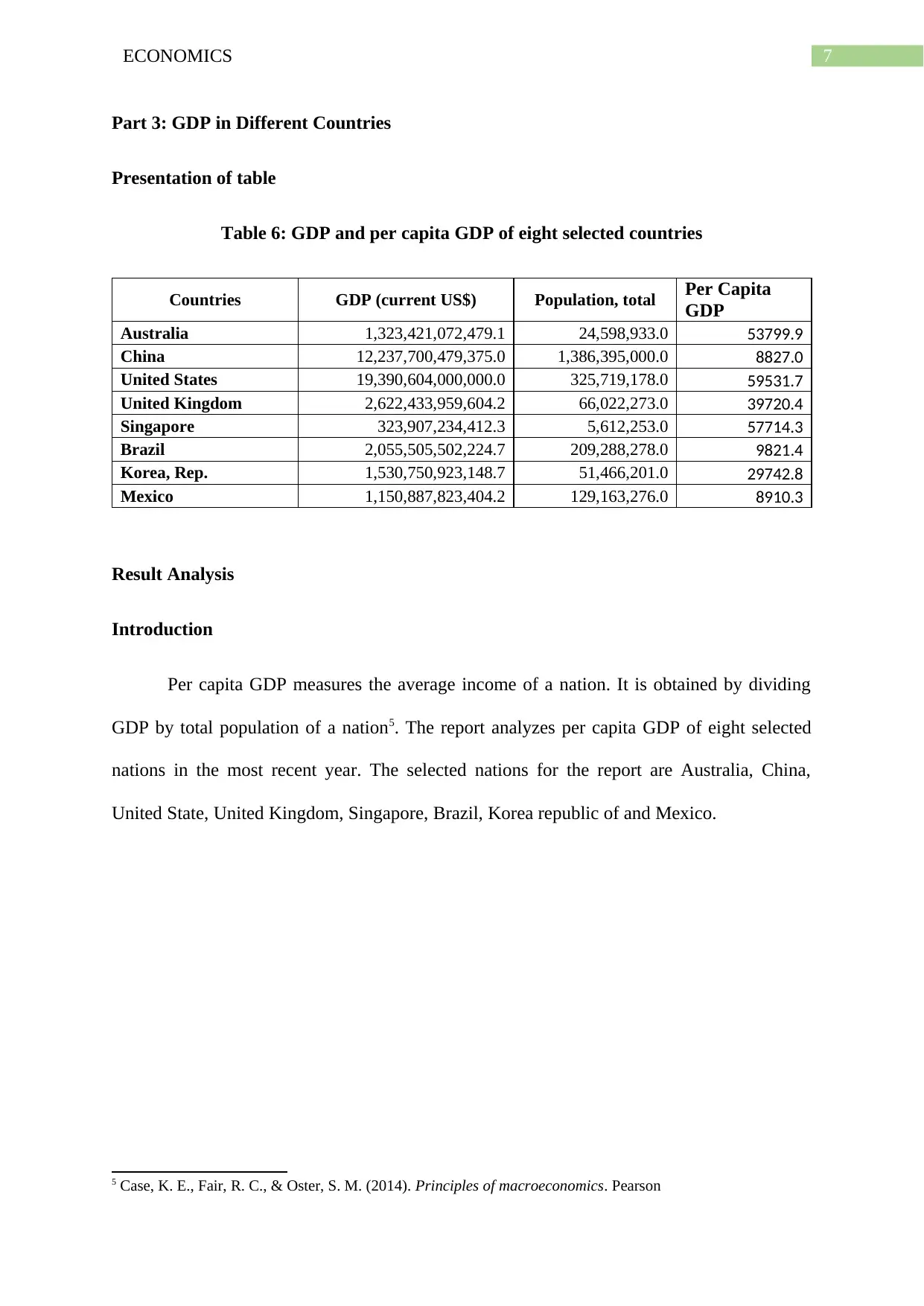
7ECONOMICS
Part 3: GDP in Different Countries
Presentation of table
Table 6: GDP and per capita GDP of eight selected countries
Countries GDP (current US$) Population, total Per Capita
GDP
Australia 1,323,421,072,479.1 24,598,933.0 53799.9
China 12,237,700,479,375.0 1,386,395,000.0 8827.0
United States 19,390,604,000,000.0 325,719,178.0 59531.7
United Kingdom 2,622,433,959,604.2 66,022,273.0 39720.4
Singapore 323,907,234,412.3 5,612,253.0 57714.3
Brazil 2,055,505,502,224.7 209,288,278.0 9821.4
Korea, Rep. 1,530,750,923,148.7 51,466,201.0 29742.8
Mexico 1,150,887,823,404.2 129,163,276.0 8910.3
Result Analysis
Introduction
Per capita GDP measures the average income of a nation. It is obtained by dividing
GDP by total population of a nation5. The report analyzes per capita GDP of eight selected
nations in the most recent year. The selected nations for the report are Australia, China,
United State, United Kingdom, Singapore, Brazil, Korea republic of and Mexico.
5 Case, K. E., Fair, R. C., & Oster, S. M. (2014). Principles of macroeconomics. Pearson
Part 3: GDP in Different Countries
Presentation of table
Table 6: GDP and per capita GDP of eight selected countries
Countries GDP (current US$) Population, total Per Capita
GDP
Australia 1,323,421,072,479.1 24,598,933.0 53799.9
China 12,237,700,479,375.0 1,386,395,000.0 8827.0
United States 19,390,604,000,000.0 325,719,178.0 59531.7
United Kingdom 2,622,433,959,604.2 66,022,273.0 39720.4
Singapore 323,907,234,412.3 5,612,253.0 57714.3
Brazil 2,055,505,502,224.7 209,288,278.0 9821.4
Korea, Rep. 1,530,750,923,148.7 51,466,201.0 29742.8
Mexico 1,150,887,823,404.2 129,163,276.0 8910.3
Result Analysis
Introduction
Per capita GDP measures the average income of a nation. It is obtained by dividing
GDP by total population of a nation5. The report analyzes per capita GDP of eight selected
nations in the most recent year. The selected nations for the report are Australia, China,
United State, United Kingdom, Singapore, Brazil, Korea republic of and Mexico.
5 Case, K. E., Fair, R. C., & Oster, S. M. (2014). Principles of macroeconomics. Pearson
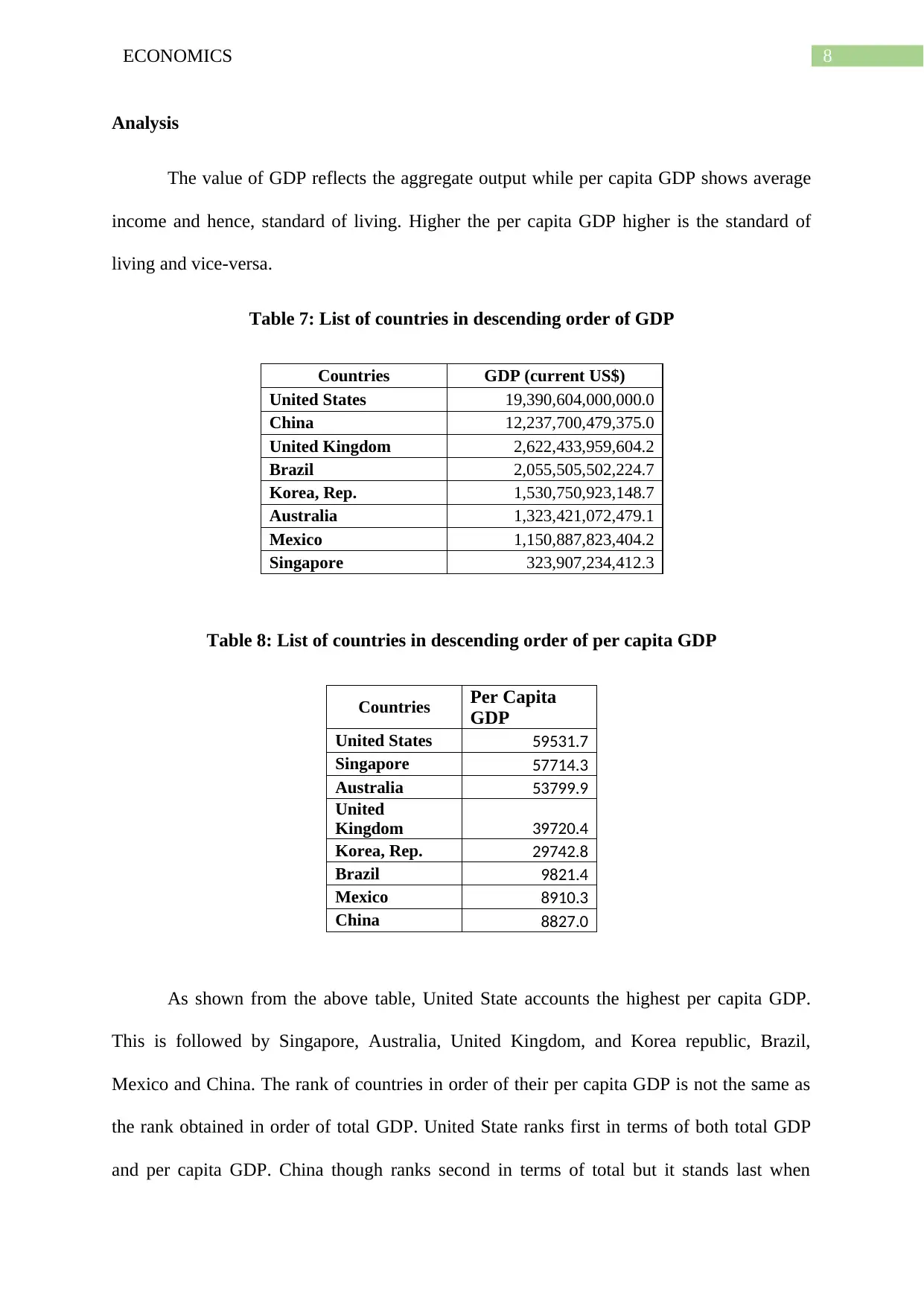
8ECONOMICS
Analysis
The value of GDP reflects the aggregate output while per capita GDP shows average
income and hence, standard of living. Higher the per capita GDP higher is the standard of
living and vice-versa.
Table 7: List of countries in descending order of GDP
Countries GDP (current US$)
United States 19,390,604,000,000.0
China 12,237,700,479,375.0
United Kingdom 2,622,433,959,604.2
Brazil 2,055,505,502,224.7
Korea, Rep. 1,530,750,923,148.7
Australia 1,323,421,072,479.1
Mexico 1,150,887,823,404.2
Singapore 323,907,234,412.3
Table 8: List of countries in descending order of per capita GDP
Countries Per Capita
GDP
United States 59531.7
Singapore 57714.3
Australia 53799.9
United
Kingdom 39720.4
Korea, Rep. 29742.8
Brazil 9821.4
Mexico 8910.3
China 8827.0
As shown from the above table, United State accounts the highest per capita GDP.
This is followed by Singapore, Australia, United Kingdom, and Korea republic, Brazil,
Mexico and China. The rank of countries in order of their per capita GDP is not the same as
the rank obtained in order of total GDP. United State ranks first in terms of both total GDP
and per capita GDP. China though ranks second in terms of total but it stands last when
Analysis
The value of GDP reflects the aggregate output while per capita GDP shows average
income and hence, standard of living. Higher the per capita GDP higher is the standard of
living and vice-versa.
Table 7: List of countries in descending order of GDP
Countries GDP (current US$)
United States 19,390,604,000,000.0
China 12,237,700,479,375.0
United Kingdom 2,622,433,959,604.2
Brazil 2,055,505,502,224.7
Korea, Rep. 1,530,750,923,148.7
Australia 1,323,421,072,479.1
Mexico 1,150,887,823,404.2
Singapore 323,907,234,412.3
Table 8: List of countries in descending order of per capita GDP
Countries Per Capita
GDP
United States 59531.7
Singapore 57714.3
Australia 53799.9
United
Kingdom 39720.4
Korea, Rep. 29742.8
Brazil 9821.4
Mexico 8910.3
China 8827.0
As shown from the above table, United State accounts the highest per capita GDP.
This is followed by Singapore, Australia, United Kingdom, and Korea republic, Brazil,
Mexico and China. The rank of countries in order of their per capita GDP is not the same as
the rank obtained in order of total GDP. United State ranks first in terms of both total GDP
and per capita GDP. China though ranks second in terms of total but it stands last when
⊘ This is a preview!⊘
Do you want full access?
Subscribe today to unlock all pages.

Trusted by 1+ million students worldwide
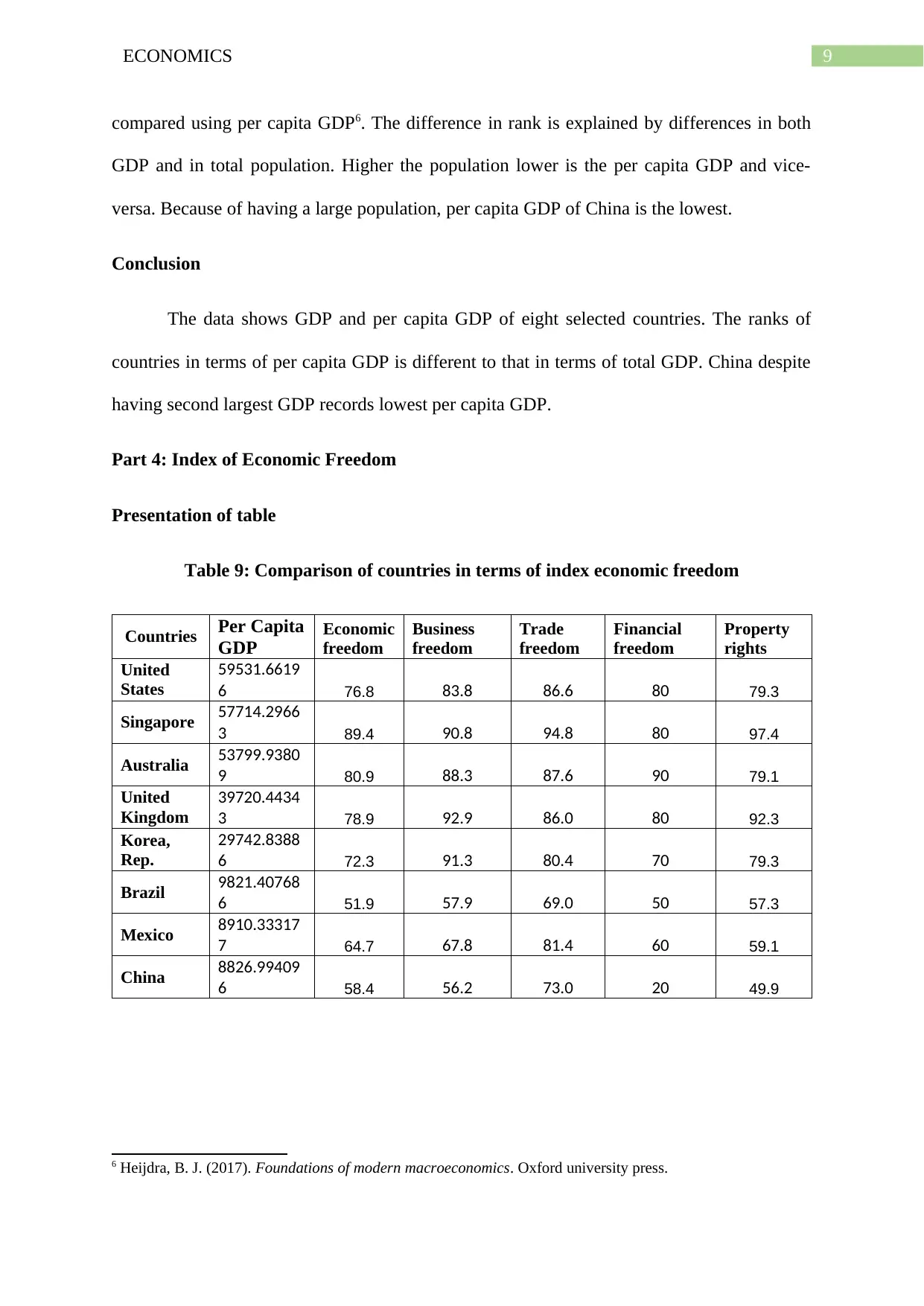
9ECONOMICS
compared using per capita GDP6. The difference in rank is explained by differences in both
GDP and in total population. Higher the population lower is the per capita GDP and vice-
versa. Because of having a large population, per capita GDP of China is the lowest.
Conclusion
The data shows GDP and per capita GDP of eight selected countries. The ranks of
countries in terms of per capita GDP is different to that in terms of total GDP. China despite
having second largest GDP records lowest per capita GDP.
Part 4: Index of Economic Freedom
Presentation of table
Table 9: Comparison of countries in terms of index economic freedom
Countries Per Capita
GDP
Economic
freedom
Business
freedom
Trade
freedom
Financial
freedom
Property
rights
United
States
59531.6619
6 76.8 83.8 86.6 80 79.3
Singapore 57714.2966
3 89.4 90.8 94.8 80 97.4
Australia 53799.9380
9 80.9 88.3 87.6 90 79.1
United
Kingdom
39720.4434
3 78.9 92.9 86.0 80 92.3
Korea,
Rep.
29742.8388
6 72.3 91.3 80.4 70 79.3
Brazil 9821.40768
6 51.9 57.9 69.0 50 57.3
Mexico 8910.33317
7 64.7 67.8 81.4 60 59.1
China 8826.99409
6 58.4 56.2 73.0 20 49.9
6 Heijdra, B. J. (2017). Foundations of modern macroeconomics. Oxford university press.
compared using per capita GDP6. The difference in rank is explained by differences in both
GDP and in total population. Higher the population lower is the per capita GDP and vice-
versa. Because of having a large population, per capita GDP of China is the lowest.
Conclusion
The data shows GDP and per capita GDP of eight selected countries. The ranks of
countries in terms of per capita GDP is different to that in terms of total GDP. China despite
having second largest GDP records lowest per capita GDP.
Part 4: Index of Economic Freedom
Presentation of table
Table 9: Comparison of countries in terms of index economic freedom
Countries Per Capita
GDP
Economic
freedom
Business
freedom
Trade
freedom
Financial
freedom
Property
rights
United
States
59531.6619
6 76.8 83.8 86.6 80 79.3
Singapore 57714.2966
3 89.4 90.8 94.8 80 97.4
Australia 53799.9380
9 80.9 88.3 87.6 90 79.1
United
Kingdom
39720.4434
3 78.9 92.9 86.0 80 92.3
Korea,
Rep.
29742.8388
6 72.3 91.3 80.4 70 79.3
Brazil 9821.40768
6 51.9 57.9 69.0 50 57.3
Mexico 8910.33317
7 64.7 67.8 81.4 60 59.1
China 8826.99409
6 58.4 56.2 73.0 20 49.9
6 Heijdra, B. J. (2017). Foundations of modern macroeconomics. Oxford university press.
Paraphrase This Document
Need a fresh take? Get an instant paraphrase of this document with our AI Paraphraser
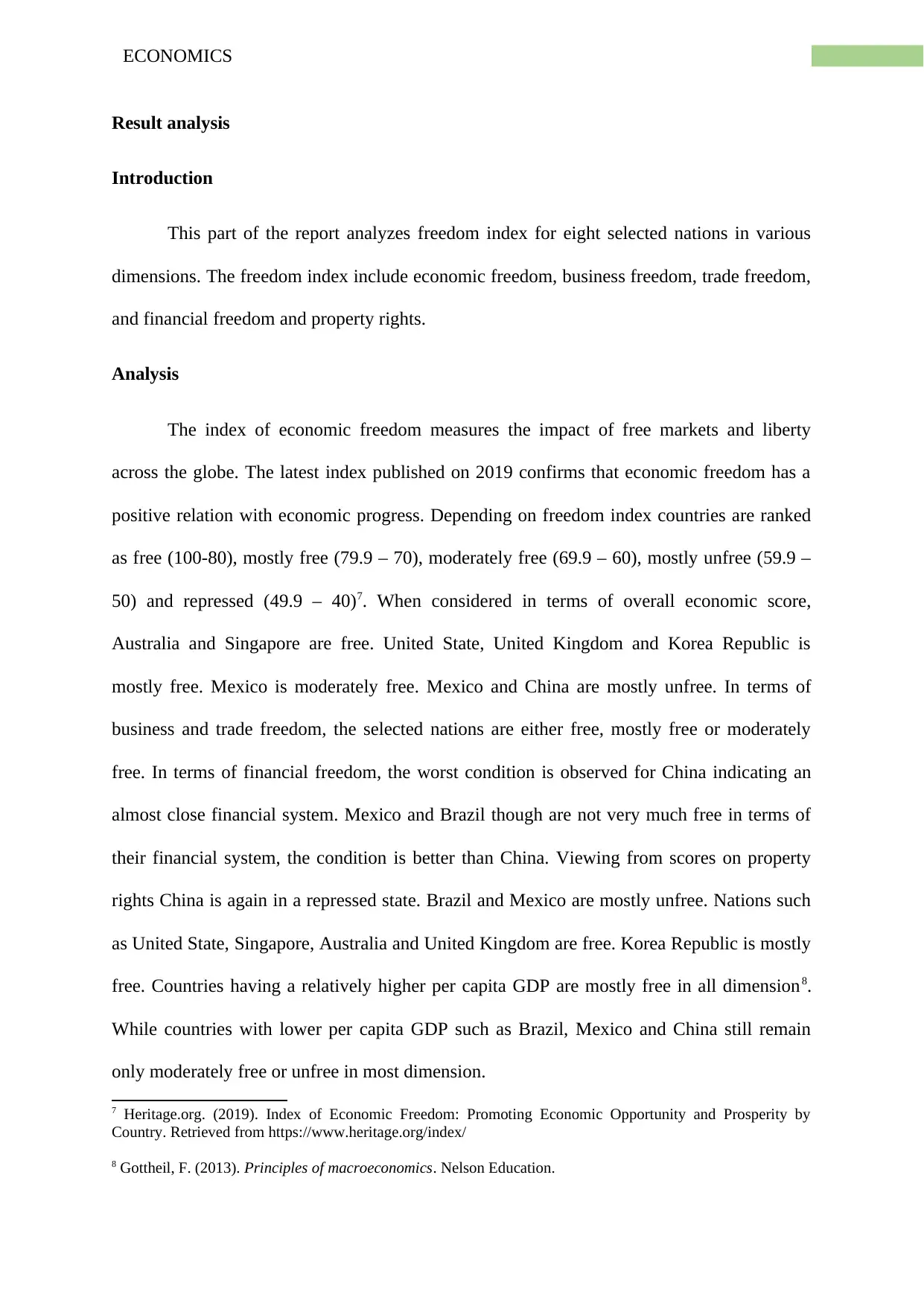
10ECONOMICS
Result analysis
Introduction
This part of the report analyzes freedom index for eight selected nations in various
dimensions. The freedom index include economic freedom, business freedom, trade freedom,
and financial freedom and property rights.
Analysis
The index of economic freedom measures the impact of free markets and liberty
across the globe. The latest index published on 2019 confirms that economic freedom has a
positive relation with economic progress. Depending on freedom index countries are ranked
as free (100-80), mostly free (79.9 – 70), moderately free (69.9 – 60), mostly unfree (59.9 –
50) and repressed (49.9 – 40)7. When considered in terms of overall economic score,
Australia and Singapore are free. United State, United Kingdom and Korea Republic is
mostly free. Mexico is moderately free. Mexico and China are mostly unfree. In terms of
business and trade freedom, the selected nations are either free, mostly free or moderately
free. In terms of financial freedom, the worst condition is observed for China indicating an
almost close financial system. Mexico and Brazil though are not very much free in terms of
their financial system, the condition is better than China. Viewing from scores on property
rights China is again in a repressed state. Brazil and Mexico are mostly unfree. Nations such
as United State, Singapore, Australia and United Kingdom are free. Korea Republic is mostly
free. Countries having a relatively higher per capita GDP are mostly free in all dimension8.
While countries with lower per capita GDP such as Brazil, Mexico and China still remain
only moderately free or unfree in most dimension.
7 Heritage.org. (2019). Index of Economic Freedom: Promoting Economic Opportunity and Prosperity by
Country. Retrieved from https://www.heritage.org/index/
8 Gottheil, F. (2013). Principles of macroeconomics. Nelson Education.
Result analysis
Introduction
This part of the report analyzes freedom index for eight selected nations in various
dimensions. The freedom index include economic freedom, business freedom, trade freedom,
and financial freedom and property rights.
Analysis
The index of economic freedom measures the impact of free markets and liberty
across the globe. The latest index published on 2019 confirms that economic freedom has a
positive relation with economic progress. Depending on freedom index countries are ranked
as free (100-80), mostly free (79.9 – 70), moderately free (69.9 – 60), mostly unfree (59.9 –
50) and repressed (49.9 – 40)7. When considered in terms of overall economic score,
Australia and Singapore are free. United State, United Kingdom and Korea Republic is
mostly free. Mexico is moderately free. Mexico and China are mostly unfree. In terms of
business and trade freedom, the selected nations are either free, mostly free or moderately
free. In terms of financial freedom, the worst condition is observed for China indicating an
almost close financial system. Mexico and Brazil though are not very much free in terms of
their financial system, the condition is better than China. Viewing from scores on property
rights China is again in a repressed state. Brazil and Mexico are mostly unfree. Nations such
as United State, Singapore, Australia and United Kingdom are free. Korea Republic is mostly
free. Countries having a relatively higher per capita GDP are mostly free in all dimension8.
While countries with lower per capita GDP such as Brazil, Mexico and China still remain
only moderately free or unfree in most dimension.
7 Heritage.org. (2019). Index of Economic Freedom: Promoting Economic Opportunity and Prosperity by
Country. Retrieved from https://www.heritage.org/index/
8 Gottheil, F. (2013). Principles of macroeconomics. Nelson Education.

11ECONOMICS
Conclusion
The data on economic freedom when compared to per capita GDP of selected nations
show a positive relation between per capita GDP and freedom in different dimension.
Countries having larger per capita GDP are mostly open in all dimension.
Conclusion
The data on economic freedom when compared to per capita GDP of selected nations
show a positive relation between per capita GDP and freedom in different dimension.
Countries having larger per capita GDP are mostly open in all dimension.
⊘ This is a preview!⊘
Do you want full access?
Subscribe today to unlock all pages.

Trusted by 1+ million students worldwide
1 out of 13
Related Documents
Your All-in-One AI-Powered Toolkit for Academic Success.
+13062052269
info@desklib.com
Available 24*7 on WhatsApp / Email
![[object Object]](/_next/static/media/star-bottom.7253800d.svg)
Unlock your academic potential
Copyright © 2020–2025 A2Z Services. All Rights Reserved. Developed and managed by ZUCOL.





